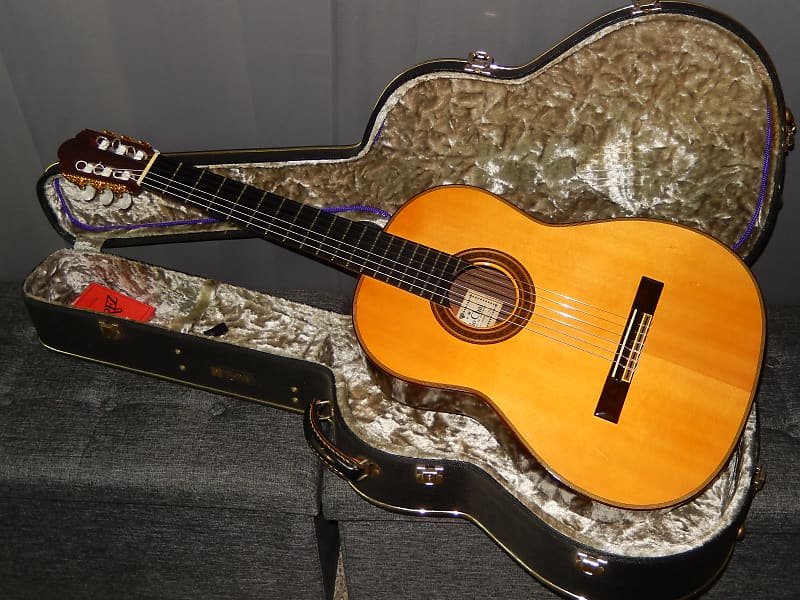

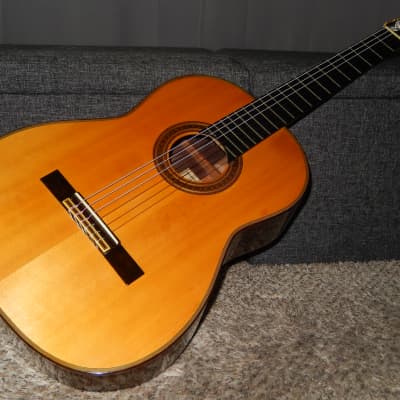
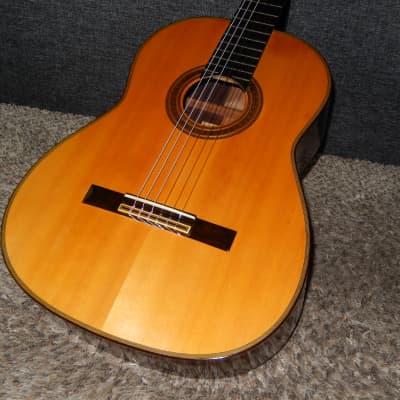
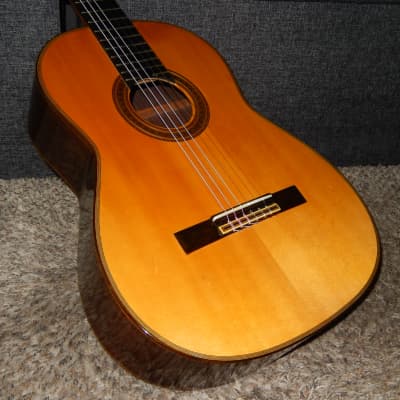
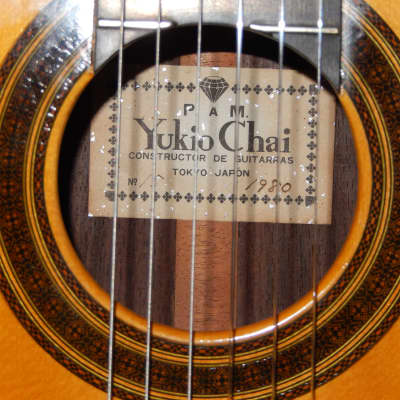
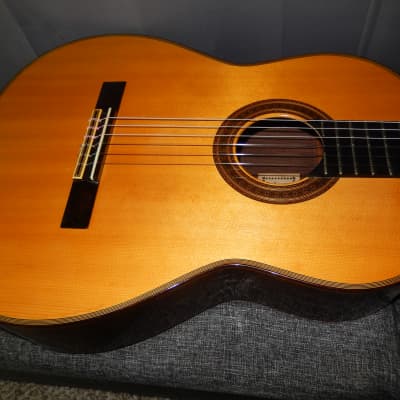
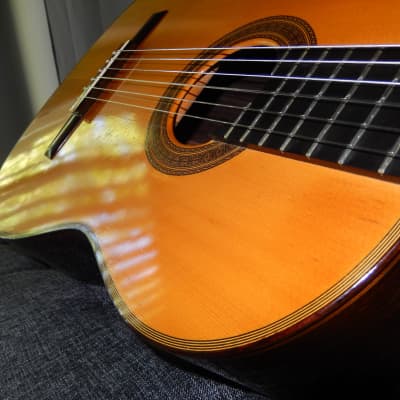
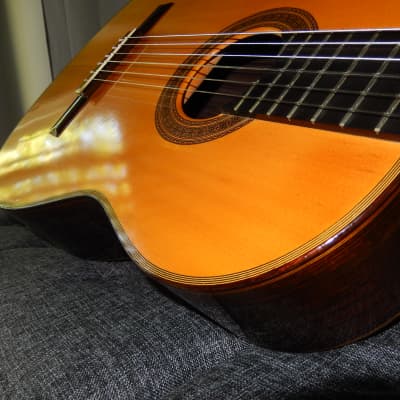
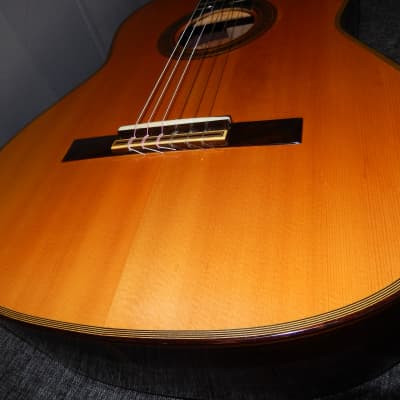
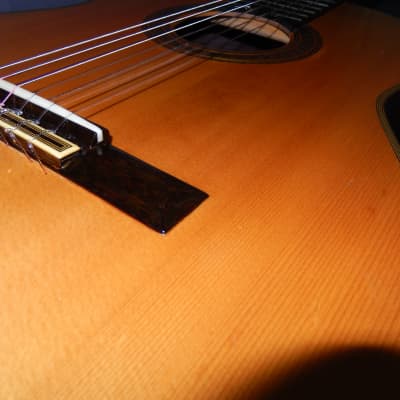
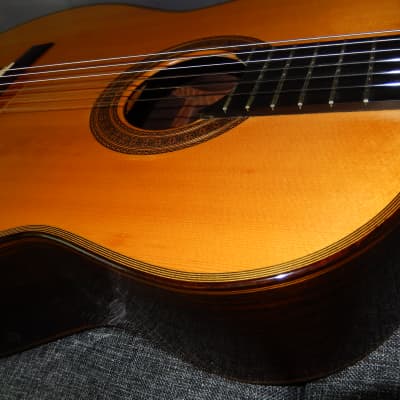
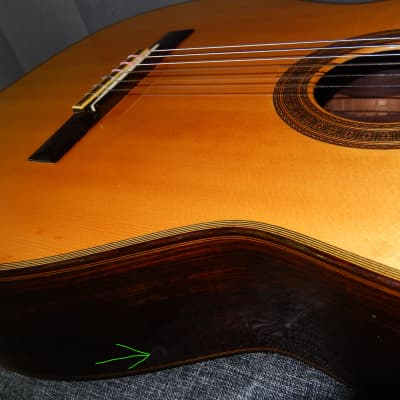
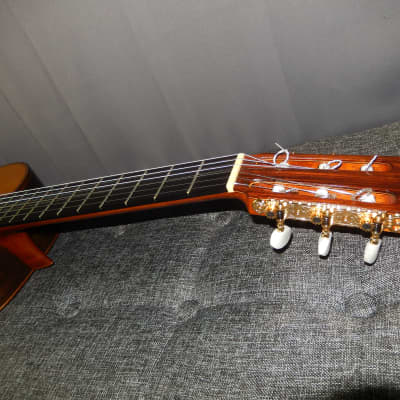
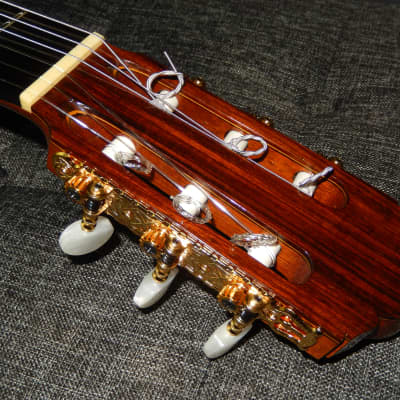
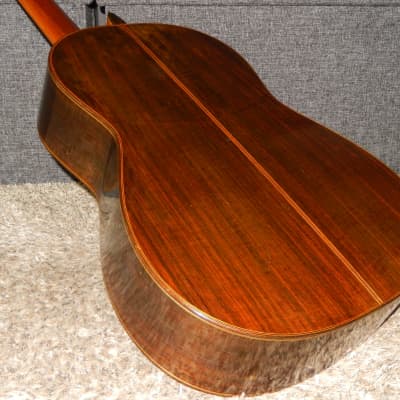
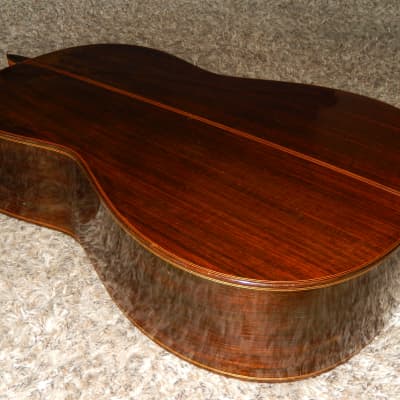
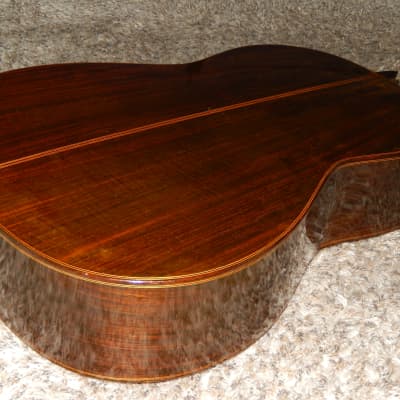
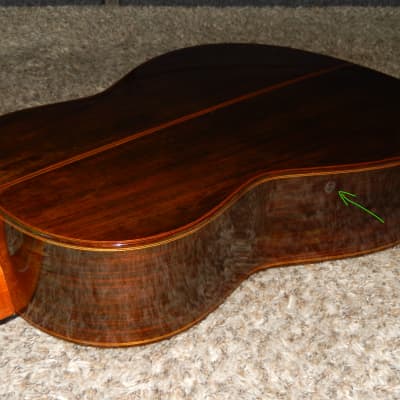
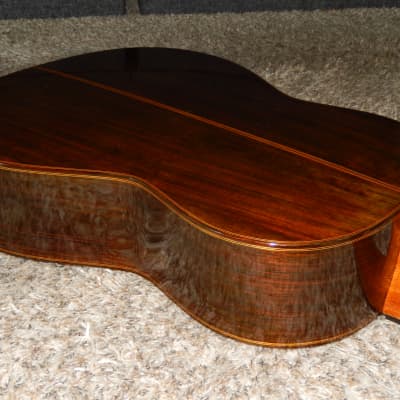
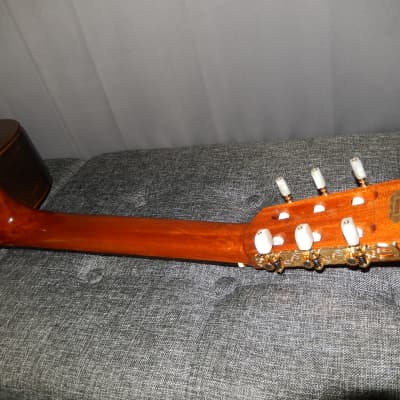
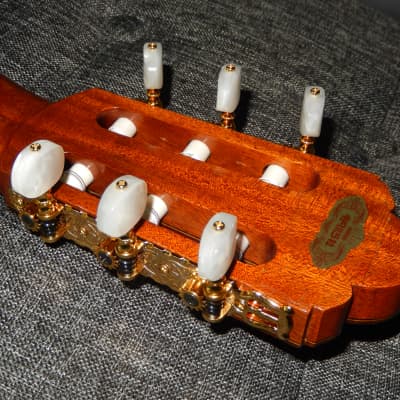
Several hundred guitars I have sold in the past are presented at Facebook.com/Victors.Guitar.Library.
Yukio Chai No15 1980
The guitar you are looking at was made in 1980 by Yukio Chai, a younger brother of Yukinobu Chai. While it has modified headstock design, it is nothing but a great “copy” of Hermann Hauser guitars. It certainly can challenge “the originals”.
Both Chai brothers started their independent careers in mid 1960s. While Yukio was highly regarded by Japanese players, it was Yukinobu who became somewhat more prominent and who in early 1980s became a major supplier of guitars for Niibori School of Guitar Ensemble, hence was running a shop with several apprentices. Yukio remained independent running a small shop making rather limited number of guitars each year. Most of his fine instruments were great “copies” of guitars made by world famous makers.
Just like many others less affluent Japanese luthiers, Yukio Chai couldn’t price his great guitars at the same level as Masaru Kohno or Yamaha. While his model No15 was priced the same 150 000 yen, it sounds far better than Kohno No15 or Yamaha GC15 from the same year.
In 1980 great majority of 200 000 yen Japanese made classical guitars were made with solid figured Brazilian Rosewood b/s. Some were made solid straight grain BR. There have been some 200 000 yen models made with non-solid (figured or straight grain) Brazilian Rosewood (usually double backs and/or double sides).
For many makers 200 000 yen models were the top of the line, while some makers were selling their very top models for 150 000 yen (e.g. Ryoji Mastuoka No150, MH150, MR150, Kazuo Yairi YC150 or Takamine 15). Yamaha’s top models were GC30A, GC30B (priced 300 000 yen). Masaru Kohno’s top model was No50 and Sakazo Nakade’s No.5000 (priced 500 000 yen).
Less prominent luthiers had to accept far lower prices for their equally great instruments. In 1980 it was not very difficult to find in Japan a very high grade instrument made with solid figured BR b/s priced 150 000 yen (e.g. Takeo Koba No15, Hakusui Imai No15). However, in just few years prices of most of these guitars had gone up by 50% on average. By 1982 very few 200 000 yen models (Ryoji Matsuoka M200, Takamine 20 or Yamaha GC20) were still made with solid figured Brazilian Rosewood b/s. Kazuo Yairi was the only “crazy” manufacturer to sell similar guitars for 150 000 yen (models YC150, H15, T15). However, his “custom shop” models were priced no less than 200 00 yen.
As of today, French polished classical guitars made by Japanese elite luthiers with 40+ years old woods are priced minimum $5000USD. If they are made by Spanish elite luthiers, they are priced minimum $8000USD.
This guitar absolutely deserves to be called a “Grand Concert Guitar”. It offers immense volume, superb response combined with sweet and very lyrical tonality, with rich basses and piano like trebles, high level of note clarity and separation, high level of transparency and very extended sustain. Even though it is made with Spruce top, this guitar offers a bit of warmth. It truly is a beautiful instrument.
Even though its body bears several minor cosmetic flaws the overall condition of this guitar can still be described as “excellent for its age”. Its French Polished top bears several very light scratches that are visible only if looked at from certain angles, hence rather difficult to photograph. There is also one pea size blemish within the finish on its side, while other surfaces are free from any conspicuous dents or scratches. On the back of the headstock there is sticker and traces of clear tape, which can be removed if necessary. Visible in the pictures finish cloudiness is very mild in regular light.
Most importantly this guitar is structurally sound, its neck is straight, fingerboard and frets in excellent condition. Defective original tuners were replaced with brand new Gotoh set.
Specification:
Top: High Grade Solid Spruce/Hauser bracing/Shellac
Back& Sides: Solid Indian Rosewood/ Cashew lacquer
Neck: Mahogany
Fingerboard: Ebony
Nut width: 51mm
Scale: 650 mm
The action is set to 4.00 mm under E6 and 3.5 mm under E1, with plenty of extra room on the saddle.
This guitar will be shipped in original used hard shell case in still good condition.
When contemporary Japanese luthiers are using 40+ years old soundboards to make “all solid woods” guitar it is priced at least $5000USD. Guitars with artificially aged (“baked”) soundboards are priced at least $4500USD. Solid top models with 40+ years old soundboards are priced at least $3500USD. American, Australian and European luthiers usually charge 50% more.
It is a matter of basic education (not beliefs) to realize that 50+ years old soundboard of this guitar alone is worth $2500USD.
Real Value of Japanese Vintage Guitars
The key to understand value of vintage Japanese guitars is to acknowledge galloping price inflation (devaluation of Japanese yen) during 1960s & 1970s. This inflation slowed down in 1980s.
During 1960s and most of 1970s model numbers of Japanese guitars were strictly interconnected with their prices in Japanese yen. By early 1980s and during following decades model numbers were no longer strictly associated with their prices. Some Japanese guitar makers introduced model names instead of model numbers. Others were still using model numbers with addition of letters and/or other symbols.
It is then important to understand that two Yamaha GC10 guitars made 10 years apart are two instruments of totally different class. The same applies to any other Japanese maker/brand.
The logical way to estimate the true class of any given Japanese made instrument is to compare its price with the average annual salary of wage workers in Japanese private sectors. This salary was: 450 600 yen in 1965 - 825 900 yen in 1970 - 1 868 300 yen in 1975 - 2 689 000 yen in 1980 - 3 163 000 yen in 1985 - 3 761 000 yen in 1990 - 4 107 000 yen in 1995 - 4 082 000 yen in 2000.
Any guitar priced 100 000 yen in 1970 (labelled as No10 or No100) would be priced 200 000 yen in 1975 (relabeled to No20, No200 or 2000), 300 000 yen in 1977 (labelled as No3, No30 or 3000) and 500 000 yen by 1985 (labelled as No50 or 5000).
Starting in 1977 Masaru Kohno introduced his new models No40 priced 400 000 yen and No50 priced 500 000 yen. By early 1980s Kohno started using model names instead of numbers and was steadily raising their prices without changing model labeling. His very top model 50 became model “Special”, and a decade later it became model “Maestro”. Naturally, all other Japanese guitar makers were doing similar pricing (labelling) upgrades.
Knowing all of that, you can bet on that Masaru Kohno No50 made in 1982 is practically the same grade instrument as Kohno No20 made in 1972, or Kohno no 30 made in 1975.
In early 1970s the lowest Ryoji Matsuoka (all plywood) model was 10, followed by (solid top) models 15, 20, 25, 30, 40, 50, 60, 80 and (all solid woods) models 100 and 150. Models 50, 60 and 80 were made with non-solid figured Brazilian Rosewood (double) back and sides and top model 150 was the only one made with solid figured Brazilian Rosewood b/s.
In 1980 the lowest Matsuoka model was (all plywood) 20, followed by (solid top) models 30,40,50, 60 and all solid woods models 80,100,150 and 200. By 1990 the lowest Matsuoka model was M40 and the highest was M300. By 2010 the lowest Matsuoka model was M50 and the top model was M270.
You can bet that Ryoji Matsuoka model 50 from 1980 is of the same grade as model M100 from 2000, model 100 from 1980 is of the same grade as model M150 from 2000, model 150 from 1980 is of the same grade as M200 from 2000 and model 200 from 1980 is of the same grade as model M300 from 2000.
It is important to mention that if modern era luthiers are using 40+ years old woods to make an “all solid” wood classical guitar, its price is minimum $8000.
All vintage guitars made with Brazilian Rosewood are especially precious, including those made straight grain varieties and those with non-solid b/s.
Because response and tonal properties of Spruce soundboards are improving over time, long seasoned Spruces are far more precious than long seasoned Cedars.
It is not very difficult to find out what are current prices of such guitars made by world’s leading luthiers.
Important message for Australian buyers:
USPS International Priority Mail packages destined for Australia have quite restricted size (max. length is 42” and max. length + girth is 97”). For these reasons I must use the case that is no longer than 41” and therefore it may be different than the one you see on the pictures. You should ask me for any other details prior to making a purchase.
Reverb Buyer Protection
Reverb has your back if your item is lost, damaged, or doesn't match its description. Simply report any issues within 7 days and we'll help you get a full refund.Learn more about Reverb Buyer Protection.
| Listed | a year ago |
| Condition | Very Good (Used) Very Good items may show a few slight marks or scratches but are fully functional and in overall great shape.Learn more |
| Brand |
|
| Model |
|
| Finish |
|
| Categories | |
| Year |
|
| Made In |
|
| Body Shape |
|
